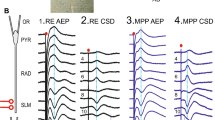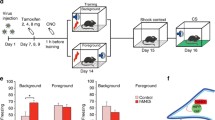Abstract
Norepinephrine has been hypothesized to provide a learning and memory signal. Norepinephrine long-term potentiation of perforant path input to the dentate gyrus of the hippocampus provides a model for norepinephrine initiated memory processes. However, in vitro, the pairing of perforant path stimulation and norepinephrine is not required for the occurrence of norepinephrine-dependent long-term potentiation. Since bath application of norepinephrine induces long-term changes in 2nd messenger signalling and differs in a number of ways from physiological norepinephrine release, the present study is an in vivo test of the associative requirement for the pairing of perforant path input with norepinephrine to induce long-term potentiation. Phasic activation of the locus coeruleus is provided by glutamate infusion into the locus coeruleus to initiate transient norepinephrine release in the hippocampus of urethane-anesthetized Sprague-Dawley rats. Perforant path stimulation (0.067 Hz) was given throughout the experiment in the paired condition. In the unpaired condition perforant path stimulation was interrupted 10 min prior to locus coeruleus activation and resumed 10 min after locus coeruleus activation. Locus coeruleus-induced long-term potentiation of both EPSP slope and population spike only occurred in the pairing condition. This result argues that, in vivo, temporal proximity of locus coeruleus-associated norepinephrine release and perforant path stimulation are required to induce long-term plasticity. The associativity requirement for locus coeruleus activation and perforant path stimulation in vivo is consistent with the hypothesis that norepinephrine can initiate circuit changes supporting learning and memory.





Similar content being viewed by others
References
Alger BE, Teyler TJ (1976) Long-term and short-term plasticity in the CA1, CA3, and dentate regions of the rat hippocampal slice. Brain Res 110:463–480
Aston-Jones G, Shipley MT, Grzanna R (1995) The locus coeruleus, A5 and A7 noradrenergic cell groups. In: Paxinos G (ed) The rat nervous system. Academic Press, New York, pp 183–214
Bliss TV, Lomo T (1973) Long-lasting potentiation of synaptic transmission in the dentate area of the anaesthetized rabbit following stimulation of the perforant path. J Physiol 232:331–356
Dahl D, Sarvey JM (1989) Norepinephrine induces pathway-specific long-lasting potentiation and depression in the hippocampal dentate gyrus. Proc Natl Acad Sci USA 86:4776–4780
Dahl D, Sarvey JM (1990) Beta-adrenergic agonist-induced long-lasting synaptic modifications in hippocampal dentate gyrus require activation of NMDA receptors, but not electrical activation of afferents. Brain Res 526:347–350
Diamond DM, Campbell AM, Park CR, Halonen J, Zoladz PR (2007) The temporal dynamics model of emotional memory processing: a synthesis on the neurobiological basis of stress-induced amnesia, flashbulb and traumatic memories, and the Yerkes-Dodson law. Neural Plast 2007:60803
Elmslie KS, Cohen DH (1990) Iontophoresis of norepinephrine onto neurons of the pigeon’s lateral geniculate nucleus: characterization of an inhibitory response. Brain Res 517:134–142
Frey S, Bergado-Rosado J, Seidenbecher T, Pape HC, Frey JU (2001) Reinforcement of early long-term potentiation (early-LTP) in dentate gyrus by stimulation of the basolateral amygdala: heterosynaptic induction mechanisms of late-LTP. J Neurosci 21:3697–3703
Gibbs CM, Cohen DH, Broyles JL (1986) Modification of the discharge of lateral geniculate neurons during visual learning. J Neurosci 6:627–636
Gilbert ME, Mack CM (1999) Field potential recordings in dentate gyrus of anesthetized rats: stability of baseline. Hippocampus 9:277–287
Harley CW, Evans S (1988) Locus coeruleus-induced enhancement of the perforant path evoked potential: effects of intradentate beta blockers. In: Woody CD, Alkon DL, McGaugh JL (eds) Cellular mechanisms of conditioning and behavioral plasticity. Plenum, New York, pp 415–423
Harley CW, Milway JS (1986) Glutamate ejection in the locus coeruleus enhances the perforant path-evoked population spike in the dentate gyrus. Exp Brain Res 63:143–150
Harley CW, Sara SJ (1992) Locus coeruleus bursts induced by glutamate trigger delayed perforant path spike amplitude potentiation in the dentate gyrus. Exp Brain Res 89:581–587
Harley CW, Lalies MD, Nutt DJ (1996) Estimating the synaptic concentration of norepinephrine in dentate gyrus which produces beta-receptor mediated long-lasting potentiation in vivo using microdialysis and intracerebroventricular norepinephrine. Brain Res 710:293–298
Harris EW, Lasher SS, Steward O (1978) Habituation-like decrements in transmission along the normal and lesion-induced temporodentate pathways in the rat. Brain Res 151:623–631
Harris EW, Lasher SS, Steward O (1979) Analysis of the habituation-like changes in transmission in the temporodentate pathway of the rat. Brain Res 162:21–32
Kety SS (1970) The biogenic amines in the central nervous system: their possible roles in arousal, emotion and learning. In: Schmidt FO (ed). Rockefeller Press, New York, pp 324–335
Klukowski G, Harley CW (1994) Locus coeruleus activation induces perforant path-evoked population spike potentiation in the dentate gyrus of awake rat. Exp Brain Res 102:165–170
Lacaille JC, Harley CW (1985) The action of norepinephrine in the dentate gyrus: beta-mediated facilitation of evoked potentials in vitro. Brain Res 358:210–220
Moriceau S, Wilson DA, Levine S, Sullivan RM (2006) Dual circuitry for odor-shock conditioning during infancy: corticosterone switches between fear and attraction via amygdala. J Neurosci 26:6737–6748
Neuman RS, Harley CW (1983) Long-lasting potentiation of the dentate gyrus population spike by norepinephrine. Brain Res 273:162–165
Palamarchouk VS, Zhang J, Zhou G, Swiergiel AH, Dunn AJ (2000) Hippocampal norepinephrine-like voltammetric responses following infusion of corticotropin-releasing factor into the locus coeruleus. Brain Res Bull 51:319–326
Palamarchouk VS, Swiergiel AH, Dunn AJ (2002) Hippocampal noradrenergic responses to CRF injected into the locus coeruleus of unanesthetized rats. Brain Res 950:31–38
Rick JT, Milgram NW (1999) Instability of dentate gyrus field potentials in awake and anesthetized rats. Hippocampus 9:333–339
Sarvey JM, Burgard EC, Decker G (1989) Long-term potentiation: studies in the hippocampal slice. J Neurosci Methods 28:109–124
Stanton PK, Sarvey JM (1985a) The effect of high-frequency electrical stimulation and norepinephrine on cyclic AMP levels in normal versus norepinephrine-depleted rat hippocampal slices. Brain Res 358:343–348
Stanton PK, Sarvey JM (1985b) Blockade of norepinephrine-induced long-lasting potentiation in the hippocampal dentate gyrus by an inhibitor of protein synthesis. Brain Res 361:276–283
Stanton PK, Sarvey JM (1987) Norepinephrine regulates long-term potentiation of both the population spike and dendritic EPSP in hippocampal dentate gyrus. Brain Res Bull 18:115–119
Stone EA, John SM (1990) In vivo measurement of extracellular cyclic AMP in the brain: use in studies of beta-adrenoceptor function in nonanesthetized rats. J Neurochem 55:1942–1949
Stone EA, Zhang Y, Carr KD (1995) Massive activation of c-fos in forebrain after mechanical stimulation of the locus coeruleus. Brain Res Bull 36:77–80
Walling SG, Harley CW (2004) Locus ceruleus activation initiates delayed synaptic potentiation of perforant path input to the dentate gyrus in awake rats: a novel beta-adrenergic- and protein synthesis-dependent mammalian plasticity mechanism. J Neurosci 24:598–604
Walling SG, Nutt DJ, Lalies MD, Harley CW (2004) Orexin-A infusion in the locus ceruleus triggers norepinephrine (NE) release and NE-induced long-term potentiation in the dentate gyrus. J Neurosci 24:7421–7426
Winson J, Dahl D (1985) Action of norepinephrine in the dentate gyrus. II. Iontophoretic studies. Exp Brain Res 59:497–506
Acknowledgments
The authors wish to acknowledge support from the Natural Sciences and Engineering Council of Canada whose support to CWH permitted these experiments to be carried out.
Author information
Authors and Affiliations
Corresponding author
Rights and permissions
About this article
Cite this article
Reid, A.T., Harley, C.W. An associativity requirement for locus coeruleus-induced long-term potentiation in the dentate gyrus of the urethane-anesthetized rat. Exp Brain Res 200, 151–159 (2010). https://doi.org/10.1007/s00221-009-1955-6
Received:
Accepted:
Published:
Issue Date:
DOI: https://doi.org/10.1007/s00221-009-1955-6




